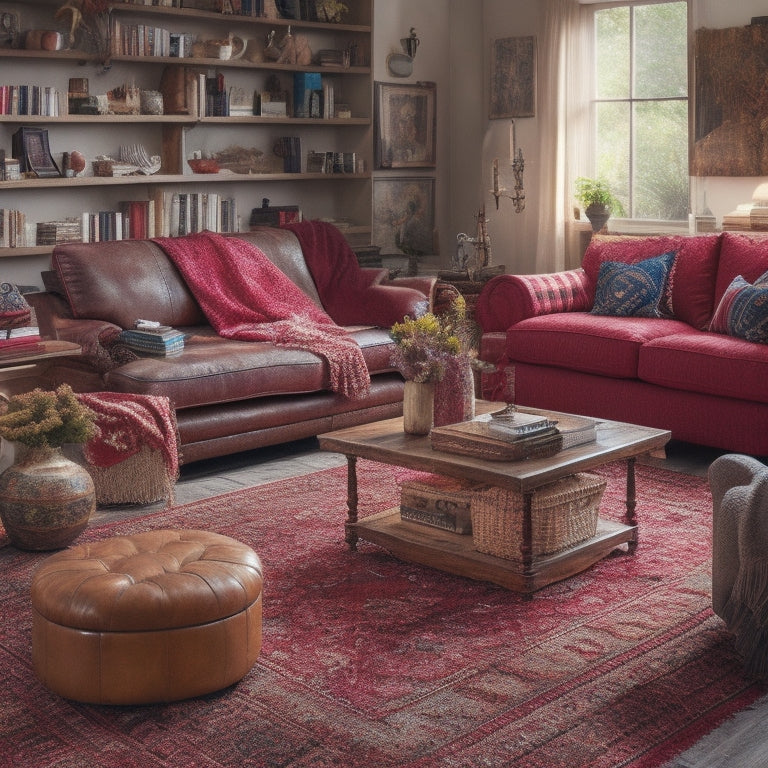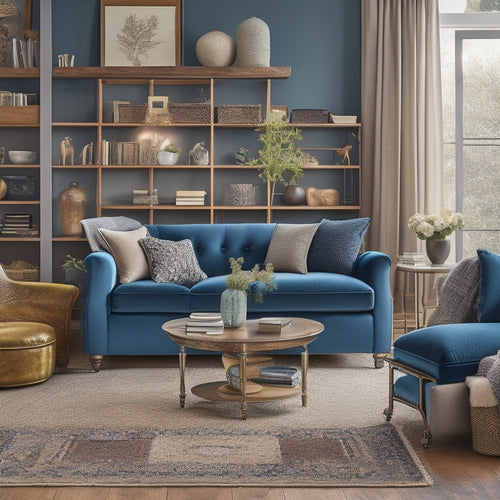
What to Remove First in a Tiny Living Room
Share
You're stuck in a tiny living room that feels suffocating. To reclaim your space, start by letting go of items you haven't touched in a year. Ask yourself if each item brings joy or serves a purpose - if not, it's time to say goodbye. Next, tackle clutter hotspots like high shelves and corners, sorting and putting back only what's necessary. Identify and remove unused furniture pieces, freeing up valuable floor space. By taking these steps, you'll create a sense of breathability and flow, and set the stage for a more intentional, peaceful living room - and that's just the beginning of your transformation.
Key Takeaways
• Remove items not used in the past year to create space and reduce clutter in your tiny living room.
• Identify and declutter hotspots like high shelves and corners to make an instant impact.
• Ditch unused furniture pieces that take up valuable floor space without serving a purpose.
• Eliminate visual clutter sources like busy patterns, excessive embellishments, and harsh lighting.
• Streamline decorations by weeding out items that don't evoke joy and prioritizing multi-functional pieces.
Prioritize Items You No Longer Need
Start by identifying items you haven't used in the past year, as they're likely taking up valuable real estate in your tiny living room for no good reason. Be honest with yourself – if you haven't touched it in 12 months, it's probably safe to let it go.
This process isn't only about decluttering, but also about personal growth. By letting go of items that no longer serve you, you're making space for new experiences, relationships, and habits that align with your current goals and values.
As you sort through your belongings, ask yourself: 'Does this item bring me joy or serve a purpose?' If the answer is no, consider donating, selling, or recycling it. By doing so, you're creating space for intentional habit formation.
You're making room for activities and hobbies that bring you joy, and that's essential in a tiny living room where every inch counts. By prioritizing what's truly important to you, you'll create a space that not only looks more organized but also feels more aligned with your values and goals.
Remove Clutter Hotspots First
Identify the areas in your tiny living room where clutter tends to accumulate, such as the coffee table, shelves, or corners, and tackle those hotspots first to create a sense of instant progress and momentum. These clutter hotspots can make your space feel cramped and overwhelming, so clearing them out will have a significant impact on the overall ambiance of your room.
Start with the high shelves, where dust-gathering decorations and forgotten trinkets often collect. Remove anything that's no longer serving a purpose or bringing you joy.
Next, turn your attention to the corner spaces, which can easily become dumping grounds for clutter. Take everything out, sort items into categories, and put back only what's necessary or useful.
Ditch Unused Furniture Pieces
How much of your tiny living room's floor space is being hogged by furniture pieces that haven't been used in months? Take a closer look around you – are there any pieces that are simply taking up space without serving a purpose?
It's time to let them go! Get rid of that dusty armchair or the coffee table that's only used as a dumping ground for mail and keys. By ditching these unused furniture pieces, you'll not only reclaim valuable floor space but also create a sense of breathability and flow in your tiny living room.
Think of it as a Furniture Revival – by removing the unnecessary, you're making way for the essential pieces to shine. You'll be amazed at how much more spacious and inviting your room feels without the clutter. And, as a bonus, you'll be freeing up space for new, functional pieces that'll make your life easier.
Become a Space Reclaimer and take back control of your tiny living room's layout. Start by identifying those unused furniture pieces and giving them the boot – your space (and your sanity) will thank you!
Eliminate Visual Clutter Sources
To evaluate your space's color schemes, start by assessing your space's color schemes. Too many bold or bright colors can create a sense of chaos. Consider toning down your palette to 2-3 calming colors that promote serenity.
Next, tackle texture overload. Mixing too many textures, such as velvet, linen, and wood, can create visual noise. Limit your textures to 2-3 per room to create a sense of cohesion. Remove any items with busy patterns or excessive embellishments, as they can contribute to visual clutter.
Finally, take a closer look at your lighting. Harsh or overly bright lighting can exacerbate cluttered feelings. Consider switching to softer, warm-toned lighting to create a calming ambiance.
Streamline Your Decorations
About 75% of your decorative items are likely stealing space and attention from the few that truly matter, so start by weeding out anything that doesn't evoke a sense of joy or serve a purpose. Be ruthless – if you haven't used or looked at it in the past year, it's probably safe to let it go.
Here are some tips to help you streamline your decorations:
-
Limit your color palette: Stick to 2-3 main colors and their variations to create a cohesive look that's easy on the eyes.
-
Mix textures wisely: Combine smooth, rough, and soft textures to add depth and visual interest to your space.
-
Prioritize multi-functional pieces: Choose items that serve more than one purpose, like a storage ottoman or a desk with built-in shelving.
- Group similar items together: Create vignettes or collections of similar items, like vintage vases or framed photos, to create a sense of cohesion and visual calm.
Frequently Asked Questions
How Do I Decide What Is Truly Essential in My Tiny Living Room?
You start by identifying your personal priorities, considering what brings you joy and serves a purpose. Then, weigh those against your space limitations, asking yourself what can be adapted or replaced to optimize your tiny living room's functionality.
Can I Donate or Repurpose Items Instead of Throwing Them Away?
You can breathe new life into items by donating or repurposing them, like turning old crates into creative storage or transforming vintage finds into unique upcycled decor, reducing waste and adding character to your space.
What if I Have Sentimental Attachments to Certain Items or Furniture?
You're torn between keeping items with memories attached and letting go of emotional clutter. Ask yourself: Can I take a photo of the item, write down the memory, and let it go, freeing up space and energy?
How Can I Ensure My Remaining Items Still Serve Multiple Purposes?
'You'll want to prioritize Space Savers and Multi-Functional items, like an ottoman with storage or a desk with built-in shelving, to maximize your tiny living room's potential and guarantee each piece serves multiple purposes.'
Are There Any Specific Design Principles for Tiny Living Rooms I Should Follow?
As you envision your tiny living room, imagine a harmonious balance of elements. To achieve this, you'll want to employ a scale strategy, ensuring each piece serves a purpose, and carefully craft a visual flow that guides the eye through the space.
Related Posts
-

What Makes the Best DIY Storage Ottoman?
When constructing your ideal DIY storage ottoman, consider essential features like color, size, upholstery, and compl...
